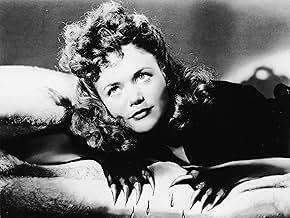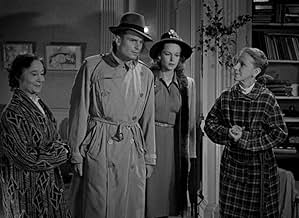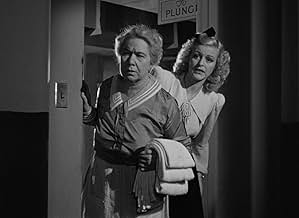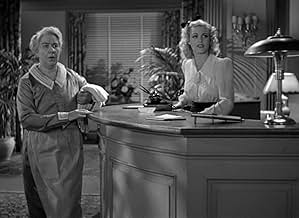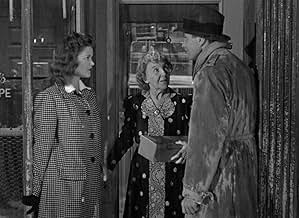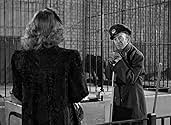VALUTAZIONE IMDb
7,2/10
27.313
LA TUA VALUTAZIONE
Un americano sposa un'immigrata Serba convinta di essere vittima di una maledizione che la trasformerà in una donna gatto se ha rapporti intimi con lui.Un americano sposa un'immigrata Serba convinta di essere vittima di una maledizione che la trasformerà in una donna gatto se ha rapporti intimi con lui.Un americano sposa un'immigrata Serba convinta di essere vittima di una maledizione che la trasformerà in una donna gatto se ha rapporti intimi con lui.
- Regia
- Sceneggiatura
- Star
- Premi
- 2 vittorie e 3 candidature totali
Henrietta Burnside
- Sue Ellen
- (non citato nei titoli originali)
Alec Craig
- Zookeeper
- (non citato nei titoli originali)
Eddie Dew
- Street Policeman
- (non citato nei titoli originali)
Elizabeth Dunne
- Mrs. Plunkett
- (non citato nei titoli originali)
Dynamite
- The Panther
- (non citato nei titoli originali)
Dot Farley
- Mrs. Agnew
- (non citato nei titoli originali)
Mary Halsey
- Blondie
- (non citato nei titoli originali)
Theresa Harris
- Minnie
- (non citato nei titoli originali)
Charles Jordan
- Bus Driver
- (non citato nei titoli originali)
Donald Kerr
- Taxi Driver
- (non citato nei titoli originali)
Connie Leon
- Neighbor Who Called Police
- (non citato nei titoli originali)
Murdock MacQuarrie
- Sheep Caretaker
- (non citato nei titoli originali)
Alan Napier
- Doc Carver
- (non citato nei titoli originali)
Recensione in evidenza
At the zoo, Oliver Reed (Kent Smith) sees the mysterious Irena Dubrovna (Simone Simon), who is sketching a black panther. He's intrigued by her--it seems to be love at first sight--and is surprised when she invites him into her apartment for a cup of tea. While in her apartment, he sees an odd statue of a man on horseback, holding a sword-skewered cat high in the air. Dubrovna tells him of her native Serbia, and the legend of unchristian "cat people" who were driven into the mountains. Dubrovna's behavior becomes increasingly odd, and animals often react strangely to her. Could she have something to do with the legend of the cat people?
This was director Jacques Tourneur and producer Val Lewton's first horror/thriller film together (they were to do two others together, I Walked With A Zombie (1943) and The Leopard Man (1943)), and for my money, this is the best of the three. Lewton was famous for understated, atmospheric horror that suggested more than it showed, a style that is also evident in his later collaborations with director Robert Wise (who went on to direct the infamous The Haunting (1963), which is often thought to be a pinnacle of this more "suggestive" style, although it's not a particular favorite of mine).
So what does this mean? Well, a lot of younger horror fans, for whom the oldest film that they are really familiar with in the genre is something like The Texas Chainsaw Massacre (1974) or an even more recent film, might be reluctant to call Cat People a horror film. It is "talky", doesn't contain any graphic violence, and we don't even see a horror creature/villain until just a glimpse near the very end of the film. But it is horror--the talking is centered on a captivating supernatural "myth", there are a lot of creepy, well-photographed scenes laden with heavy shadows, there are a couple exquisite chase/suspense scenes, and there is a lot of complex, dark psychological interaction.
The psychological tension is really the focus, as Lewton and Tourneur's films together are moral parables that function more as a metaphor for horror (rather than the more common flipside, where the horror is more prominent and might be a metaphor for some other kind of philosophical point). In this case, the moral and social situations are varied and complex, but are all focused on romantic relationships, ranging from quick actions taken due to lust, to emotional distancing, adultery and abuse of power. The more one watches the film, the more one is likely to get out of the subtextual messages. They remain more subtextual than they might in modern cinema because of content restrictions imposed by studios in this era (although of course those were a reaction to prevalent cultural attitudes at the time). But in retrospect, the buried nature of the themes is a benefit, at least in this case.
Occasionally, the horrific aspect of these types of films can be too understated, so that they simply become realist dramas. That's not the case here. This is a film that is rewarding on many levels.
A 9 out of 10 from me.
This was director Jacques Tourneur and producer Val Lewton's first horror/thriller film together (they were to do two others together, I Walked With A Zombie (1943) and The Leopard Man (1943)), and for my money, this is the best of the three. Lewton was famous for understated, atmospheric horror that suggested more than it showed, a style that is also evident in his later collaborations with director Robert Wise (who went on to direct the infamous The Haunting (1963), which is often thought to be a pinnacle of this more "suggestive" style, although it's not a particular favorite of mine).
So what does this mean? Well, a lot of younger horror fans, for whom the oldest film that they are really familiar with in the genre is something like The Texas Chainsaw Massacre (1974) or an even more recent film, might be reluctant to call Cat People a horror film. It is "talky", doesn't contain any graphic violence, and we don't even see a horror creature/villain until just a glimpse near the very end of the film. But it is horror--the talking is centered on a captivating supernatural "myth", there are a lot of creepy, well-photographed scenes laden with heavy shadows, there are a couple exquisite chase/suspense scenes, and there is a lot of complex, dark psychological interaction.
The psychological tension is really the focus, as Lewton and Tourneur's films together are moral parables that function more as a metaphor for horror (rather than the more common flipside, where the horror is more prominent and might be a metaphor for some other kind of philosophical point). In this case, the moral and social situations are varied and complex, but are all focused on romantic relationships, ranging from quick actions taken due to lust, to emotional distancing, adultery and abuse of power. The more one watches the film, the more one is likely to get out of the subtextual messages. They remain more subtextual than they might in modern cinema because of content restrictions imposed by studios in this era (although of course those were a reaction to prevalent cultural attitudes at the time). But in retrospect, the buried nature of the themes is a benefit, at least in this case.
Occasionally, the horrific aspect of these types of films can be too understated, so that they simply become realist dramas. That's not the case here. This is a film that is rewarding on many levels.
A 9 out of 10 from me.
- BrandtSponseller
- 24 gen 2005
- Permalink
Trama
Lo sapevi?
- QuizThe horror movie technique of slowly building tension to a jarring shock which turns out to be something completely harmless and benign became known as a "Lewton bus" after a famous scene in this movie created by producer Val Lewton. The technique is also referred to as a "cat scare," as off-screen noises are often revealed to be a startled harmless cat.
- BlooperWhen Irena does not show up at her apartment when Dr. Judd, Oliver, and Alice are waiting for her, they leave. Dr. Judd hides his cane in the apartment to give him an excuse to borrow Oliver's key and go back in for it. Afterward, he leaves the door unlocked so that he can sneak back in, something that is hidden from Oliver and Alice. Yet, after Oliver and Alice are threatened in the office, they call the apartment to warn Dr. Judd that Irena is definitely dangerous and that he should leave.
- Citazioni
Irena Dubrovna: I like the dark. It's friendly.
- Curiosità sui crediti[From the opening credits] "Even as fog continues to lie in the valleys, so does ancient sin cling to the low places, the depression sin the world consciousness." - "The Anatomy of Atavism" - Dr. Louis Judd
- ConnessioniFeatured in Draculeena Presents: Cat People (1960)
I più visti
Accedi per valutare e creare un elenco di titoli salvati per ottenere consigli personalizzati
Dettagli
- Data di uscita
- Paese di origine
- Lingue
- Celebre anche come
- Il figlio della notte
- Luoghi delle riprese
- Azienda produttrice
- Vedi altri crediti dell’azienda su IMDbPro
Botteghino
- Budget
- 134.000 USD (previsto)
- Tempo di esecuzione1 ora 13 minuti
- Colore
- Proporzioni
- 1.37 : 1
Contribuisci a questa pagina
Suggerisci una modifica o aggiungi i contenuti mancanti

Divario superiore
By what name was Il bacio della pantera (1942) officially released in India in English?
Rispondi















